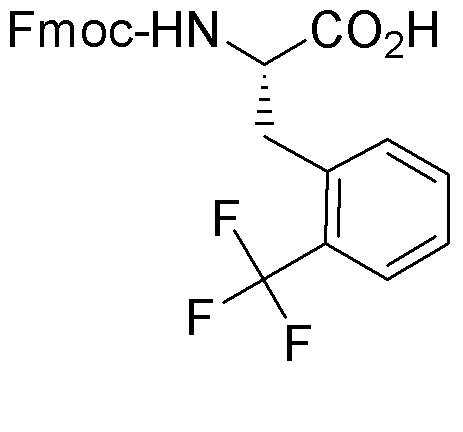Fmoc-L-Phe(2-trifluoromethyl)-OH is widely utilized in research focused on:
- Peptide Synthesis: This compound serves as a key building block in solid-phase peptide synthesis, allowing researchers to create complex peptides with high purity and yield.
- Drug Development: Its unique trifluoromethyl group enhances the pharmacological properties of peptides, making it valuable in the design of new therapeutic agents.
- Bioconjugation: The chemical's functional groups facilitate bioconjugation processes, enabling the attachment of peptides to various biomolecules for targeted drug delivery systems.
- Research in Cancer Therapy: Its application in developing peptide-based drugs shows promise in targeting cancer cells more effectively, potentially leading to improved treatment outcomes.
- Material Science: The compound can be used in creating advanced materials with specific properties, such as increased stability and enhanced interactions with biological systems.
General Information
Properties
Safety and Regulations
Applications
Fmoc-L-Phe(2-trifluoromethyl)-OH is widely utilized in research focused on:
- Peptide Synthesis: This compound serves as a key building block in solid-phase peptide synthesis, allowing researchers to create complex peptides with high purity and yield.
- Drug Development: Its unique trifluoromethyl group enhances the pharmacological properties of peptides, making it valuable in the design of new therapeutic agents.
- Bioconjugation: The chemical's functional groups facilitate bioconjugation processes, enabling the attachment of peptides to various biomolecules for targeted drug delivery systems.
- Research in Cancer Therapy: Its application in developing peptide-based drugs shows promise in targeting cancer cells more effectively, potentially leading to improved treatment outcomes.
- Material Science: The compound can be used in creating advanced materials with specific properties, such as increased stability and enhanced interactions with biological systems.
Documents
Safety Data Sheets (SDS)
The SDS provides comprehensive safety information on handling, storage, and disposal of the product.
Product Specification (PS)
The PS provides a comprehensive breakdown of the product’s properties, including chemical composition, physical state, purity, and storage requirements. It also details acceptable quality ranges and the product's intended applications.
Certificates of Analysis (COA)
Search for Certificates of Analysis (COA) by entering the products Lot Number. Lot and Batch Numbers can be found on a product’s label following the words ‘Lot’ or ‘Batch’.
*Catalog Number
*Lot Number
Certificates Of Origin (COO)
This COO confirms the country where the product was manufactured, and also details the materials and components used in it and whether it is derived from natural, synthetic, or other specific sources. This certificate may be required for customs, trade, and regulatory compliance.
*Catalog Number
*Lot Number
Safety Data Sheets (SDS)
The SDS provides comprehensive safety information on handling, storage, and disposal of the product.
DownloadProduct Specification (PS)
The PS provides a comprehensive breakdown of the product’s properties, including chemical composition, physical state, purity, and storage requirements. It also details acceptable quality ranges and the product's intended applications.
DownloadCertificates of Analysis (COA)
Search for Certificates of Analysis (COA) by entering the products Lot Number. Lot and Batch Numbers can be found on a product’s label following the words ‘Lot’ or ‘Batch’.
*Catalog Number
*Lot Number
Certificates Of Origin (COO)
This COO confirms the country where the product was manufactured, and also details the materials and components used in it and whether it is derived from natural, synthetic, or other specific sources. This certificate may be required for customs, trade, and regulatory compliance.


